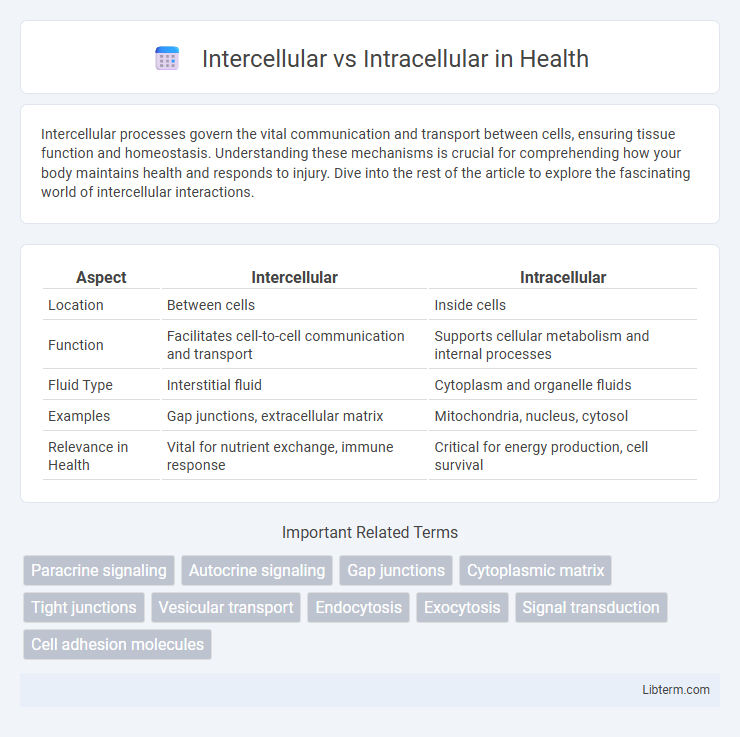Intercellular processes govern the vital communication and transport between cells, ensuring tissue function and homeostasis. Understanding these mechanisms is crucial for comprehending how your body maintains health and responds to injury. Dive into the rest of the article to explore the fascinating world of intercellular interactions.
Table of Comparison
| Aspect | Intercellular | Intracellular |
|---|---|---|
| Location | Between cells | Inside cells |
| Function | Facilitates cell-to-cell communication and transport | Supports cellular metabolism and internal processes |
| Fluid Type | Interstitial fluid | Cytoplasm and organelle fluids |
| Examples | Gap junctions, extracellular matrix | Mitochondria, nucleus, cytosol |
| Relevance in Health | Vital for nutrient exchange, immune response | Critical for energy production, cell survival |
Introduction to Cellular Communication
Intercellular communication involves the exchange of signals between different cells, enabling coordination and response to external stimuli through mechanisms such as hormone signaling, neurotransmission, and immune responses. Intracellular communication refers to the transmission of signals within a single cell, primarily through second messengers like calcium ions, cyclic AMP, and protein phosphorylation cascades that regulate cellular functions. Understanding these communication pathways is essential for deciphering complex biological processes, including tissue development, homeostasis, and disease progression.
Defining Intercellular and Intracellular Processes
Intercellular processes involve communication and interactions between adjacent cells, playing a crucial role in tissue formation, immune responses, and cellular signaling pathways. Intracellular processes occur within a single cell, encompassing activities such as metabolism, gene expression, and organelle function that maintain cell viability and functionality. Understanding both intercellular and intracellular mechanisms is essential for comprehending complex biological systems and cellular behavior.
Key Differences Between Intercellular and Intracellular Activities
Intercellular activities occur between cells and involve communication, signaling, and transport of molecules through the extracellular matrix or gap junctions, essential for tissue coordination. Intracellular activities take place within a single cell, encompassing metabolic processes, protein synthesis, and organelle functions critical for maintaining cell survival and function. The key difference lies in the spatial context: intercellular activities facilitate interaction between cells, while intracellular activities focus on processes inside the cell's cytoplasm and organelles.
Mechanisms of Intercellular Signaling
Intercellular signaling involves communication between cells through chemical signals like hormones, neurotransmitters, and cytokines that bind to specific receptors on target cell membranes, triggering intracellular responses. Mechanisms include paracrine signaling, where signaling molecules affect nearby cells, endocrine signaling through bloodstream for distant cells, and juxtacrine signaling requiring direct cell-to-cell contact. These processes regulate essential physiological functions such as immune responses, tissue repair, and cellular growth by coordinating actions across multiple cells.
Intracellular Signal Transduction Pathways
Intracellular signal transduction pathways involve the transmission of molecular signals from a cell's exterior to its interior, activating specific cellular responses. Key components include receptors, secondary messengers such as cAMP or calcium ions, and effector proteins that regulate gene expression, metabolism, or cytoskeletal dynamics. These pathways enable cells to respond rapidly and precisely to environmental stimuli, maintaining homeostasis and coordinating complex activities like growth and apoptosis.
Intercellular Communication in Multicellular Organisms
Intercellular communication in multicellular organisms involves the exchange of signals between adjacent or distant cells to coordinate function and maintain homeostasis. This process occurs through mechanisms such as gap junctions, paracrine signaling, and hormonal pathways, allowing cells to respond collectively to environmental changes. Efficient intercellular communication is essential for tissue development, immune responses, and overall organismal coordination.
Importance of Intracellular Processes in Cell Function
Intracellular processes are critical for maintaining cell function by regulating metabolic pathways, protein synthesis, and signal transduction within the cytoplasm and organelles such as the nucleus, mitochondria, and endoplasmic reticulum. These processes ensure energy production, cellular repair, and communication necessary for cell survival and adaptation. Proper intracellular activity supports cell growth, differentiation, and homeostasis, distinguishing it from intercellular interactions that occur between cells.
Examples of Intercellular Communication (e.g., Synaptic, Hormonal)
Intercellular communication encompasses mechanisms such as synaptic and hormonal signaling, where cells transmit messages across extracellular spaces to coordinate physiological processes. In synaptic communication, neurons release neurotransmitters into synaptic clefts to rapidly convey signals to adjacent cells, enabling precise neural responses. Hormonal communication involves endocrine cells secreting hormones into the bloodstream, allowing distant target cells to regulate functions like metabolism, growth, and reproduction.
Examples of Intracellular Responses (e.g., Gene Expression, Metabolic Regulation)
Intracellular responses include gene expression changes, where signaling molecules activate transcription factors that regulate specific genes, and metabolic regulation, involving the modulation of enzymatic activity within cells to adjust metabolic pathways. For example, the activation of nuclear receptors by steroid hormones alters gene transcription, while insulin signaling affects glucose uptake and metabolism by modifying enzyme functions inside cells. These intracellular mechanisms enable precise control of cellular functions in response to external and internal signals.
Implications for Health and Disease
Intercellular communication involves signaling between cells through molecules like hormones and neurotransmitters, crucial for maintaining tissue homeostasis and immune responses, while intracellular processes govern activities within a single cell, such as gene expression and metabolic regulation. Disruptions in intercellular signaling pathways can lead to diseases like cancer, autoimmune disorders, and chronic inflammation, whereas intracellular dysfunctions are often linked to genetic disorders, metabolic syndromes, and neurodegenerative diseases. Understanding these mechanisms offers targeted therapeutic strategies, including modulating cell signaling in cancer treatment and correcting intracellular enzyme deficiencies.
Intercellular Infographic

 libterm.com
libterm.com